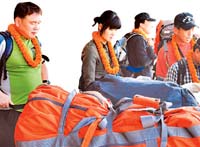

Chinese tourists shine in Nepal's tourism market

Chinese tourists are the newest wrinkle in the domestic tourism sector. Visitors from the northern neighbour are the second largest foreign travelers in the country in the last three years.
Tourism Ministry’s preliminary statistics show Nepal welcomed 85,832 Chinese tourists last year, which is more than 10 percent of the total arrivals in 2012. A total of 53,373 Chinese came to Nepal via air, while the rest came by road.
The growth in the arrival began with the government stepping up efforts to attract Chinese and Indian tourists to Nepal since 2010. “Chinese visitors have been by far the fastest growing segment over the last two years.
The overall tourist growth is satisfactory despite the protracted political transition,” said Rabi Prasad Kayastha, the chief statistician at the ministry. According to him, the number is expected to keep growing, with the air links expanding and China’s middle class growing. Travel trade entrepreneurs say the government and the private sector have now realized the potential of Chinese tourists. In the past, Nepal used to depend on European markets. However, the trend has changed with the world now seeking Chinese travellers.
The rise in Chinese visitors has cheered tourism entrepreneurs. They are, however, struggling to determine what they can offer the visitors from the north.
Hotels, restaurants and tour operators are stepping up efforts to woo big-spending Chinese visitors. “We need more entertainment-based products to divert the affluent Chinese to Nepal,” said Hari Sarmah, the chief executive officer of Nepal Association of Tour and Travel Agents. “As the Chinese are serious shoppers and entertainment seekers, Nepal lacks enough of these.”
The government statistics show that on an average, foreign tourists stay here for 13.12 days and the Chinese stay for 10.14 days, the second lowest after India.
President of Tourist Guide Association of Nepal (Turgan) Hare Ram Baral said Chinese spending in Nepal has of late superseded the spending of European travellers. The reason he gave for this trend is the economic recession in most European countries.
As the Chinese are good bargainers, they spend $60-70 a day on an average. “Although, Chinese intend to spend more, a lack of products of their choice has contained their spending,” Baral said.
The statistics show that spending by tourists on an average has dropped to $39.90 in 2011, against the $43.20 in 2010. On the other hand, the rise in unhealthy competition has led to operators handling the Chinese far below the travel budget the Chinese have allocated, Baral said.
Their favourite places in Nepal are Kathmandu, Pokhara, Jomsom and Muktinath. However, of late, soft adventure sports have also attracted them. More Chinese prefer trekking, paragliding and rafting in Nepal.
Realizing the potential, the government plans to simplify visa procedures for Chinese tourists. Ministry officials said a study team formed to recommend ways to ease visa procedures has submitted its report to the Prime Minister’s Office (PMO) and the Home and Foreign ministries for further discussions.
The team has recommended setting up diplomatic missions in different parts of China for the convenience of prospective Chinese visitors to Nepal. The report has also proposed appointing agents or Visa Facilitation Services (VFS) in major Chinese cities. The VFS, an outsourced partner to facilitate visa applications, is in operation in a number of countries.
The Chinese government has asked Nepal to revise the bilateral air service agreement (ASA) between the two countries as the travel demand has outstripped the seat capacity given to Chinese carriers. Three Chinese carriers—Air China, China Southern and China Eastern—currently land at Kathmandu’s Tribhuvan International Airport (TIA).
source: The Kathmandu Post,11 jan 2013
“There has been a growth in number of trekkers but trekking in our country is still limited to only three regions,” said chief executive officer of Trekking Agencies’ Association of Nepal (TAAN) Gangaram Pant.
Trekking activities are limited to the Annapurna, Langtang and Everest regions. “The government and the private sector must work together to diversify trekking destinations,” he said.
In 2012, TAAN in coordination with the government started around 12 different trekking destinations but due to lack of proper infrastructure and quality promotion, trekkers have been concentrated in only Annapurna, Langtang and Everest regions. “We are also planning to develop new trekking routes to Humla starting from March this year,” he said.
According to TAAN, among various trekking destinations, around 80 per cent tourists are mainly attracted to Annapurna, Everest and Langtang regions and a few others also opt for Lower Dolpa, Ganesh Himal and some trek to restricted areas such as Manaslu, Manang and Chun Valley.
In 2012, TAAN issued more than 87,000 TIMS card for group trekkers while the number was 83,000 in 2011, and in 2010 it was around 68,000. In addition, the number of individual trekkers was around 1.5 lakh in 2012.
Meanwhile, the number of trekkers to the restricted regions was around 12,000. “The government allows a limited number of trekkers in the restricted regions, that is around 10,000, but figures show an increased number of trekkers attracted to the restricted regions for trekking,” said Pant.
The government has restricted Manaslu, Mustang and Chun Valley for trekking. However, it allows a limited number of trekkers and a guide is a must with additional entry charges.
“It is time we offered trekkers more options along with our traditional destinations, which will minimise the crowd at
the regular destinations and promote other destinations too,” said Pant.
According to him, it is difficult to trace the nationality of trekkers and destinations they are travelling to. “We do not have specific data of the places the trekkers will be travelling to but now we are planning to introduce a barcode system which will make it easier to record details and trace the trekkers and the destinations they are travelling to,” he said.
source: The Himalayan Times,11 Jan 2013








